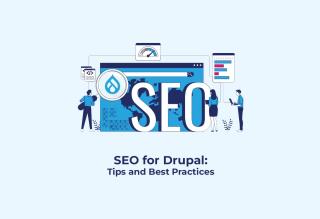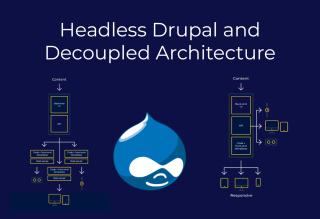If you are a nonprofit organisation trying to increase your online presence, or a government institution searching for an enhanced digital functionality, or a B2B or a B2C business who wants to stay competitive, in these cases you need to migrate or upgrade your Drupal website is a usual challenge.
In this glob we are going to understand the importance of Drupal Migration and get a sense of the Drupal Migration, Integration, customization, support and consultation services , while assisting in your Drupal Migration to achieve your business goals in making a difference in the industry.
Is Drupal still in demand. What percentage of websites use Drupal
On the internet, over 9 percent of the top 10,000 websites uses Drupal. Indeed, Drupal is still and continues to be a most demanded CMS, along with the others like WordPress, Joomla, Magento, and Wix. However, Drupal has some unique features that we will unpack in this glob.

What is Drupal Migration
In Drupal Migration, the users will have to encounter any one of these three process.
-
Migration from a different CMS to Drupal: In this, one have to transfer all the digital assets, content and functionalities from a different CMS platform to Drupal, in order to benefit from its robust features and flexibility.
-
Drupal Version-to-Version Migration: Consider it’s an upgrade, where a website is moved from a lower version (eg; Drupal 7) to a higher/latest version (Drupal 9/10). Here not only the content transfer but also adaptation to the latest version of Drupal, ensuring a smoother, more secure and feature rich digital experience.
-
Migration from Drupal to another CMS: This involves the transfer of all the digital assets, content and functionalities to the new CMS like WordPress, Joomla, Magento or Wix. To cater to the evolving business needs and preferences.
Each of these migration processes have its own unique challenges and opportunities, and choosing the right platform is the crucial for successful transition.
What is the difference between copying and migration
To be clear, in migration process the most critical process is the migration of the content that lives within the CMS itself. In general, the requirements and efforts of copying linearly increases with the amount of content, and if the content is more then its beneficial to go with migration.
In another sense, the Drupal Migration process transfers not just the content but also the structure, metadata and functionality ensuring that the new Drupal website resembles the same as the old website with modern enhancements.
How are Drupal integrations used
The use cases of Drupal Integrations are not just vast but limitless, because the platform being open source, community members can respond to the latest updates spontaneously, often more quickly than counterparts who work with proprietary or closed systems.
For example, the lightning-quick development of the Chat GPT integration in content editing, which allowed us to capitalise on the AI wave very early on and offer fully functional features in Drupal for free.
Again, Drupal is open source, anyone can fiddle with the modules and use them as a starting point for their own experiments.
That’s the case with any of Drupal’s modules - even those that have been around for a while. The point being: While the platform’s library of APIs is massive, organisation may still need to create or improve upon a module to meet their needs. We’ll touch on this topic again in a bit, but for now, lets review the most common categories in which the integration modules fall.
Common Drupal integrations
Not to pick too much on it, but there are a plethora of systems that Drupal can interface with. Let's take a look at some of the most popular categories, although it features modules for email service providers, analytics, electronic health records, and much more.
eCommerce integrations
To see how strong the CMS is in this area, organizations only need to look at Drupal's Commerce module, which has built-in connectors for many of the components—such as payment gateways, product information management (PIM), shipping, and returns—that go into creating the modern customer experience. Among many other companies, users can find integrations with UPS, PayPal, and Amazon. There are also direct interfaces available with Stripe, Magento, and other e-commerce platforms for users who require lighter-weight options.
Marketing Automation Integrations
Marketing automation enables marketers to respond in real time to shifting market conditions while working with fewer resources. Fortunately, Drupal integrates with some of the best known marketing automation technologies, like Campaign Studio, Pardot and Marketo.
CRM integrations
CRM solutions, which are heavily utilized by marketing, sales, and customer success teams, are an essential part of many organizations' IT stacks. Their contact and sales management, cross-team collaborations, reporting, and other objectives and metrics are powered by seamless connections with this technology. CRMs such as Hubspot, Zoho, Salesforce, and CRM interact with Drupal.
Custom integrations
As previously said, when existing modules don't quite work, organizations may easily create or improve upon integrations that match their specific needs thanks to Drupal's flexibility and openness. Actually, with the release of Drupal 8, the standardization of the APIs developers use to create integrations made the process of creating custom integrations even simpler. This capacity is based on the platform's fundamental strength, which is its structured data architecture, which makes integrations easier to do when new solutions are required.
Drupal Customisation
The theme of a website has much more influence than you might think. After all, the theme is not only the site’s colour or typography. Additionally, it’s about brand awareness and user experience. It is often the reason people stay longer on your site and become clients. With Drupal 10, you can create your own theme and stand out from the crowd. Drupal 10’s theme Starterkit is versatile, and it has brought up vast improvements to Drupal Theming by reducing dependencies, and Drupal is continuously evolving. There is no doubt that they are great and versatile. Nevertheless, custom theme development is for you if you want your website to stand out from the rest.
How to create a custom theme simply in Drupal 10? Our glob contains the answers you need to do this so keep reading.
Why Drupal for custom theme development
Drupal offers great flexibility in assembling various components to produce the optimal online user experience. Put another way, you or the development team will be able to use Drupal to precisely realize any idea you have for your website. Let's now discuss the benefits and drawbacks of creating custom themes.
Pros of Custom theme development
Fast load Compared to standard free themes, bespoke themes frequently load much faster. The adaptability of the theme improves SEO rankings and speeds up the loading of the entire website.
High security: Using custom themes increases security. Since the custom theme solely uses secure code, there is no way for any vulnerability or information to leak.
The flexibility of themes created especially for you makes it simple to update and modify them as needed.
Cons of custom theme development
Unlike a free theme, any bespoke theme costs money. Though it's not as expensive as many believe, creation is nonetheless not without expense.
Drupal Support by Power CMS
Customizable support and maintenance packages can include specialists to carry out and help with site audits, security upgrades, development, content updates, integration assistance, and more. They are designed to grow or shrink to suit the needs of the customer.
Regarding the Drupal assets within your organization, we ensure that in addition to providing round-the-clock help for any difficulties that may develop, we also proactively maintain your Drupal web site to prevent problems from ever occurring in the first place. My Webworld's support and maintenance experts, who specialize in working with enterprise-level organizations, are well-suited to manage complex and integrated environments, numerous Drupal-based properties, challenging scaling and security issues, continuous performance maintenance, and emergency support.
Drupal Consulting
Drupal consulting services enable customers to work together and take part in each stage of the process with our Drupal professionals. Starting with the examination of the needs of the business, the Drupal site is designed, tested, deployed, maintained, and upgraded. You will learn the important distinctions between Drupal development, maintenance, and consulting services from this glob. Let's begin by discussing Drupal consultancy.



